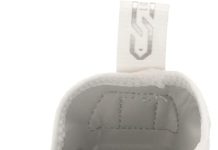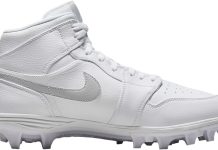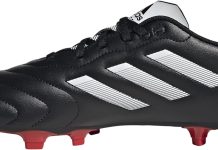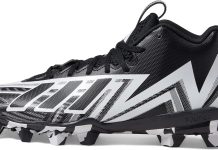If you’ve ever watched a soccer match, you might have wondered why players wear those peculiar-looking boots with studs on the soles. Well, it turns out that those studs play a crucial role in enhancing a player’s performance on the pitch.
In this article, we’ll explore the fascinating reasons behind using studs in soccer boots, uncovering the science and strategy that lies beneath one of the most iconic pieces of sports equipment. So, let’s lace up our boots and embark on a journey to uncover the secrets of the studs!
The Evolution of Soccer Boots
Soccer, or football, as it is known in many parts of the world, is a sport that has evolved over the years. As the game became faster and more competitive, so did the need for specialized footwear. Soccer boots, also known as cleats, underwent a remarkable transformation to meet the demands of the game. In this article, we will explore the evolution of soccer boots, their purpose, different types of studs, factors affecting stud design, materials used for studs, advancements in stud technology, regulations, and rules, caring for soccer boots with studs, and dispel some myths and misconceptions associated with them.
Review contents
Early Soccer Boots
In soccer’s early days, players wore regular everyday shoes to play the game. These shoes had smooth soles, making maintaining stability and traction on the field challenging. Players added small metal or leather studs to their shoes to gain some grip on the playing surface as the game became popular. This marked the beginning of the incorporation of studs in soccer boots.
Introduction of Studs
The introduction of studs in soccer boots was a game-changer. Studs are small protrusions or cleats located at the bottom of the boot to provide traction and stability on different playing surfaces. They come in various shapes and sizes, each serving a specific purpose.
Purpose of Studs
Improved Traction
One of the primary purposes of studs in soccer boots is to enhance traction. The studs dig into the ground, preventing the players from slipping and allowing them to change direction quickly without losing balance. The improved traction offered by studs enables players to maneuver the ball with greater control, giving them a competitive edge on the field.
Enhanced Stability
Studs significantly contribute to the stability of soccer boots. They create a firm grip by penetrating the ground, ensuring that players maintain their balance while making rapid movements or changing directions. This stability is crucial in preventing ankle injuries from sudden slips or falls during the game.
Reduced Slipping
Slipping is common in soccer, especially on wet or muddy fields. Studs on the soles of soccer boots reduce the likelihood of players slipping, providing them with greater confidence to perform at their best. The combination of improved traction and reduced slipping allows players to make precise movements on the field, regardless of the conditions.
Effective Ball Control
Studs play a significant role in enhancing ball control. By providing a secure grip on the ground, players can exert more force on the ball without losing footing. This allows for more accurate passes, shots, and dribbles, giving players greater control over the game’s outcome.
Prevention of Injuries
In addition to improving performance, studs also contribute to the overall safety of players. The traction and stability studs help prevent ankle sprains, twisted knees, and other injuries from slips or falls on the field. Properly chosen and maintained studs can act as a layer of protection for players, minimizing the risk of game-ending injuries.
Different Types of Studs
As the game of soccer evolved, so did the design and construction of studs. Different types of studs were developed to suit various playing surfaces and conditions. Here are some of the most common types of studs found on soccer boots today:
Conical Studs
Conical studs are the most widely used and versatile type of stud. They feature a cone-shaped design that provides 360-degree traction, allowing players to move in any direction without losing stability. Conical studs work well on firm and natural grass surfaces, making them popular among players of all skill levels.
Bladed Studs
Bladed studs are more rectangular or triangular and provide excellent traction on firm ground surfaces. Their elongated edges cut into the ground, offering stability and reducing the chances of slipping. These studs are commonly preferred by players who prioritize speed and agility on firm, well-maintained pitches.
Molded Studs
Molded studs are integral to soccer boots designed for use on artificial surfaces, such as artificial turf and synthetic grass. Made of rubber or plastic, these studs are typically shorter and rounder in shape. Molded studs are engineered to provide maximum grip and stability on surfaces with less natural traction, reducing the risk of slipping and injuries.
Screw-In Studs
Screw-in studs, also known as detachable or interchangeable studs, provide players with the highest level of customization. These studs can be unscrewed and replaced with different lengths and types, allowing players to adapt their footwear to different playing surfaces or weather conditions. Screw-in studs offer excellent traction and stability on various surfaces, making them a favorite among professional players.
Factors Affecting Stud Design
Several factors influence the design of studs, including the playing surface, weather conditions, player positions, and player preferences. Understanding these factors is crucial for both manufacturers and players when selecting the appropriate stud design for optimal performance.
Playing Surface
Different playing surfaces require different types of studs. For natural grass fields, longer studs are typically used to penetrate the turf and provide better traction. Firm ground surfaces might benefit from shorter and bladed studs, while artificial turf requires shorter and molded studs to prevent damage to the surface. By considering the specific playing surface, players can select soccer boots with studs that cater to their needs and improve their performance.
Weather Conditions
Weather conditions can significantly impact the performance of soccer boots with studs. Wet or muddy fields may necessitate longer studs to prevent slipping, while dry and hard pitches might require shorter studs for enhanced maneuverability. Some soccer boots with screw-in studs offer the flexibility to swap out studs depending on the weather conditions, ensuring optimal traction regardless of the playing surface.
Player Position
Different player positions require different stud designs to maximize performance. For example, forwards and wingers who rely on speed and agility may prefer bladed studs for rapid acceleration. Conversely, defenders might prioritize stability and opt for conical studs to maintain balance during physical challenges. Midfielders may require a combination of both, depending on their style of play. Tailoring stud design to each player’s position can significantly enhance their overall performance on the field.
Player Preference
Ultimately, player preference is crucial in selecting the right stud design. Some players may have personal preferences based on previous experiences, comfort, or perceived performance benefits. It is essential to find the perfect balance between comfort and functionality that suits each player’s unique playing style, ensuring they are confident in their footwear and free to focus on the game.
Materials Used for Studs
Studs can be made from various materials, but the three most common options are metal, plastic, and rubber. The materials used for studs can significantly impact their performance and durability.
Metal Studs
Metal studs were the norm in the early years of soccer footwear. They are incredibly durable and provide excellent traction on soft surfaces. However, using metal studs has diminished over time due to safety concerns. Metal studs can cause severe injuries when players accidentally come into contact with each other, leading to regulations limiting their use in most leagues and tournaments.
Plastic Studs
Plastic studs are the most widely used material for soccer boot studs today. They balance traction and safety well, providing excellent grip on both natural and artificial playing surfaces. Compared to metal studs, plastic studs are lightweight, durable, and less likely to cause injuries. They have become the go-to choice for both professional and casual players.
Rubber Studs
Rubber studs are primarily used in soccer boots designed for artificial turf and synthetic grass surfaces. They are engineered to provide maximum traction and stability while minimizing damage to the playing surface. Rubber studs offer a good compromise between grip and safety, making them an excellent choice for players who regularly play on artificial turf.
Advancements in Stud Technology
As technology advances, so does the design and performance of soccer boot studs. Manufacturers constantly strive to develop innovative stud features that enhance performance and reduce the risk of injuries. Here are some advancements in stud technology that have had a significant impact on the game:
Anti-Clogging Technology
Studs can become clogged with debris in muddy or wet conditions, affecting their traction. Some soccer boot manufacturers have incorporated anti-clogging technology into their stud designs to combat this issue. These advancements help prevent mud, grass, and other substances from clogging the studs, ensuring optimal grip throughout the game.
Interchangeable Studs
Interchangeable studs offer players the flexibility to switch between different types and lengths of studs depending on the playing surface or weather conditions. This allows players to adapt their footwear to various situations, ensuring the best possible grip and stability.
Responsive Studs
Responsive studs are designed to adapt to the player’s movements and playing style. They provide dynamic traction and stability, adjusting their grip based on the pressure applied. Responsive studs offer superior control and agility, enabling players to perform at their best.
Biomechanical Research
Advancements in biomechanical research have significantly influenced the development of stud technology. Manufacturers can design studs that optimize performance by studying the movements and forces exerted on the feet during soccer activities while minimizing the risk of injuries. This research has led to the creation of stud designs that provide better support, shock absorption, and stability for players.
Regulations and Rules
To ensure fair play and player safety, various regulations and rules exist regarding using soccer boots with studs. These regulations are enforced by governing bodies such as FIFA and supplemented by league and tournament rules. Here are some essential regulations and guidelines:
FIFA Regulations
FIFA, the international governing body for soccer, sets guidelines regarding the size, shape, and materials used for soccer boot studs. These regulations aim to balance player safety and fair play, minimizing the risks associated with studs while allowing optimal performance.
Artificial Turf Guidelines
Artificial turf has become increasingly popular in many soccer fields worldwide. Specific guidelines have been established to address the unique challenges and requirements of playing on artificial surfaces. These guidelines often include recommendations for stud design and materials to ensure player safety and preserve the integrity of the playing surface.
League and Tournament Rules
In addition to the regulations set by governing bodies, individual leagues and tournaments may have specific rules regarding soccer boot studs. These rules can vary depending on factors such as the level of competition and the playing surface. Players must familiarize themselves with the rules specific to their league or tournament to avoid penalties or disqualifications.
Caring for Soccer Boots with Studs
Proper care and maintenance of soccer boots with studs are essential to prolong their lifespan and ensure optimal performance. Here are some tips for caring for soccer boots with studs:
Cleaning and Maintenance
After each game or practice session, cleaning off any dirt, mud, or debris from the studs is essential. This can be done using a brush or a damp cloth. Regularly inspect the studs for wear and tear, and promptly replace any damaged or worn-out studs. Avoid leaving boots in extreme temperatures or direct sunlight, which damages the studs and affects their performance.
Replacing Worn Studs
Over time, studs may wear down due to regular use. It is crucial to inspect the studs and replace them when necessary regularly. Many soccer boot manufacturers provide replacement studs that can be easily screwed in or replaced as needed. Maintaining proper stud length is vital for optimal traction and stability on the field.
Storage
Proper storage is essential to protect the studs and maintain their integrity. Avoid storing soccer boots with studs in damp or humid environments, leading to mold or damage. It is recommended to air dry the boots after each use and store them in a cool, dry place. Additionally, shoe bags or separate compartments for each boot can help prevent damage to the studs while in storage.
Myths and Misconceptions
There are several myths and misconceptions surrounding soccer boots with studs. Let’s take a moment to address some of these:
Influencing Speed
Contrary to popular belief, soccer boot studs do not directly influence a player’s speed. While studs provide traction and stability, the player’s skill, technique, and physical attributes primarily determine their speed on the field. The design and type of studs can impact agility and maneuverability but are not the sole factor in determining a player’s speed.
Preventing Injuries
While the presence of studs can help reduce the risk of specific injuries, they do not guarantee complete injury prevention. Injuries can still occur due to factors such as high-impact collisions or awkward landings. It is important to remember that soccer boots with studs, while beneficial, are just one aspect of injury prevention. Proper warm-up routines, conditioning, and adherence to safe playing techniques are equally important in minimizing the risk of injuries.
Guaranteeing Performance
While soccer boots with the proper studs can enhance a player’s performance, they alone cannot guarantee success on the field. Skill, technique, practice, and physical conditioning all play integral roles in a player’s performance. The studs in soccer boots serve as tools to aid players in achieving their best performance, but the player’s dedication and commitment ultimately determine success.
Conclusion
The evolution of soccer boots, particularly the introduction of studs, has profoundly impacted the game of soccer. Studs provide improved traction, enhanced stability, reduced slipping, and effective ball control, and they help prevent injuries. Different types of studs, such as conical, bladed, molded, and screw-in studs, cater to various playing surfaces and player preferences.
Factors affecting stud design include the playing surface, weather conditions, player position, and preference. Metal, plastic, and rubber are the materials used for studs, each offering unique benefits. Advancements in stud technology, such as anti-clogging features, interchangeable studs, responsive studs, and biomechanical research, continue to push the boundaries of performance and safety.
Regulations and rules govern the use of soccer boots with studs, ensuring fair play and player safety. Proper care, maintenance, and storage are crucial for prolonging the lifespan of soccer boots with studs and maximizing their performance.
Finally, it is important to dispel myths and misconceptions surrounding soccer boots with studs, recognizing that while they contribute to performance and injury prevention, they are not the sole factor determining success on the field.





































